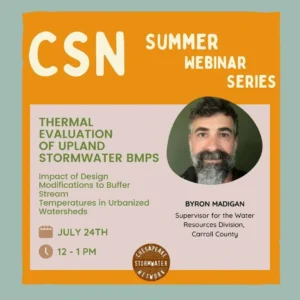 Thermal pollution from urbanization and ponding of water in stormwater management facilities is a known detriment to the biological functionality of streams. Section 502(6) of the Clean Water Act considers heat as a pollutant, and temperature continues to be a focus of the category 5 listings within MDE’s integrated report. Currently, typical stormwater retrofit designs address nutrient and sediment inputs, but do not necessarily include design elements that address thermal impacts, which likely increase stream temperatures during warmer months. Carroll County consists primarily of Use III and IV streams, and to generate a better understanding of what capacity specific BMPs have on reducing thermal impacts to the receiving waters, studies were initiated that looked at the efficacy of these practices at reducing thermal impacts to our waterways. Long-term monitoring was set up at a large sand filter BMP to understand how dry facilities buffered stormwater temperatures from pavement to tailwater. Additionally, an ongoing paired BMP study is comparing a traditional bottom release wet pond with one that incorporated a “gravel lens” around the dewatering pipe. Ideally, the “gravel lens” will provide better temperature buffering, reducing the thermal impact to receiving waterways than that of traditional bottom release wet ponds.
Thermal pollution from urbanization and ponding of water in stormwater management facilities is a known detriment to the biological functionality of streams. Section 502(6) of the Clean Water Act considers heat as a pollutant, and temperature continues to be a focus of the category 5 listings within MDE’s integrated report. Currently, typical stormwater retrofit designs address nutrient and sediment inputs, but do not necessarily include design elements that address thermal impacts, which likely increase stream temperatures during warmer months. Carroll County consists primarily of Use III and IV streams, and to generate a better understanding of what capacity specific BMPs have on reducing thermal impacts to the receiving waters, studies were initiated that looked at the efficacy of these practices at reducing thermal impacts to our waterways. Long-term monitoring was set up at a large sand filter BMP to understand how dry facilities buffered stormwater temperatures from pavement to tailwater. Additionally, an ongoing paired BMP study is comparing a traditional bottom release wet pond with one that incorporated a “gravel lens” around the dewatering pipe. Ideally, the “gravel lens” will provide better temperature buffering, reducing the thermal impact to receiving waterways than that of traditional bottom release wet ponds.Speaker Bio:
Byron Madigan
Byron Madigan has been with Carroll County for the past 16 years and is the Supervisor for the Water Resources Division within the County’s Bureau of Resource Management. In this role, he oversees the groundwater, surface water, Army Corps and MS4 monitoring programs and requirements for the County. Additionally, Byron serves as a Board of Director for Maryland’s Water Monitoring Council and recently assumed the role as chairman for the Board’s Monitoring and Assessment Subcommittee.
